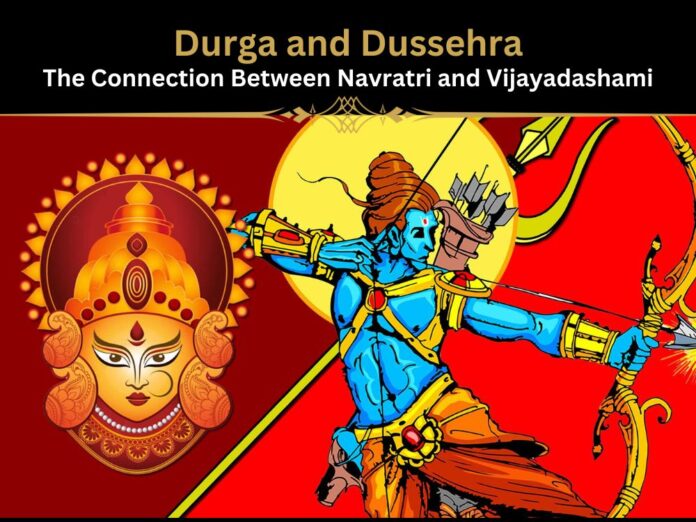Dussehra, also known as Vijayadashami, is one of the most significant festivals in India, celebrated with fervor and devotion across various states. The festival is deeply connected to Navratri, a nine-day period of worship dedicated to Goddess Durga, symbolizing the victory of good over evil. Together, these festivals highlight the spiritual essence of the divine feminine and commemorate the triumph of righteousness.
Navratri: Worshipping the Divine Feminine
Navratri, meaning ‘nine nights,’ is a Hindu festival where the nine different forms of Goddess Durga are worshipped. Each day of Navratri is dedicated to a specific avatar of the goddess, including Shailaputri, Brahmacharini, Chandraghanta, Kushmanda, Skandamata, Katyayani, Kalaratri, Mahagauri, and Siddhidatri. These forms represent different virtues of power, wisdom, strength, courage, and protection. The rituals vary from state to state, but the central theme remains the worship of Durga as the embodiment of Shakti (divine feminine power).
The celebration of Navratri is particularly grand in states like West Bengal, where the last five days are dedicated to Durga Puja, marking the victory of Durga over Mahishasura, the buffalo demon. The festival symbolizes the power of good over evil and the cyclical renewal of life and energy.
Vijayadashami: The Culmination of Navratri
The tenth day of Navratri, Vijayadashami, also known as Dussehra, marks the culmination of the festival and celebrates two important victories in Hindu mythology. First, it celebrates Durga’s victory over Mahishasura, signifying the power of feminine energy. Second, it commemorates Lord Rama’s triumph over the demon king Ravana, as narrated in the ancient epic Ramayana.
The burning of Ravana’s effigies on Dussehra symbolizes the destruction of ego and evil, reinforcing the belief that dharma (righteousness) will always triumph. In many parts of northern India, Ramlila performances, a dramatic re-enactment of Lord Rama’s victory, take center stage. These performances take place throughout the nine days of Navratri, culminating in the symbolic burning of Ravana’s effigy on the evening of Dussehra.
Durga and Rama: Two Narratives, One Festival
Although Navratri primarily revolves around Goddess Durga and Vijayadashami centers on Lord Rama’s victory, the two stories are intricately connected. Both celebrate the concept of righteousness defeating evil, with Durga’s battle against Mahishasura paralleling Rama’s fight against Ravana. These stories, though distinct, emphasize the importance of upholding dharma and the victory of good over evil.
The festival of Dussehra thus represents the completion of a spiritual journey that began with Navratri. While the first nine days are devoted to the worship of Durga in her various forms, the tenth day reflects the universal triumph of justice, whether through the actions of a divine goddess or an epic hero.
Regional Variations of Celebrations
- West Bengal: Durga Puja is celebrated with grandeur, with elaborate pandals (temporary stages) built for the goddess, culminating in her immersion in rivers on Vijayadashami, symbolizing her return to her celestial home.
- Mysore, Karnataka: The Mysore Dussehra is renowned for its grand processions featuring elephants, royal parades, and cultural performances, honoring both Durga and the Wodeyar royal family’s patron deity, Chamundeshwari.
- Kullu, Himachal Pradesh: Here, Dussehra is celebrated as a week-long festival with traditional music, dance, and fairs. The focus is on Lord Raghunath (an avatar of Rama), but the celebrations coincide with Navratri and honor Durga’s victory as well.
- Maharashtra and Gujarat: In Gujarat, Garba and Dandiya dances are performed during Navratri in honor of Durga, while Maharashtra celebrates Dasara with processions and the worship of weapons, signifying the protection and empowerment offered by Durga.
Conclusion: A Unified Celebration of Good Over Evil
Dussehra and Navratri are deeply interwoven festivals that celebrate the universal theme of the triumph of good over evil. While Navratri honors the feminine divine in the form of Durga, Vijayadashami emphasizes the destruction of ego and injustice through the stories of both Durga and Rama. This connection between the two festivals is a reminder of the power of dharma and the eternal victory of righteousness, making them a crucial part of India’s cultural and spiritual landscape.



